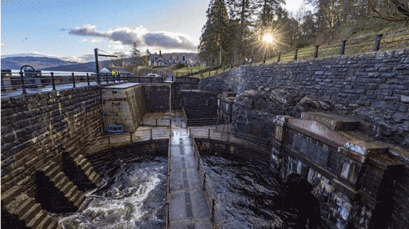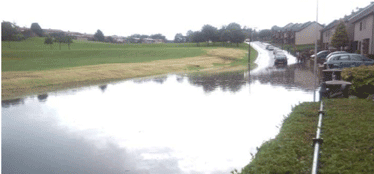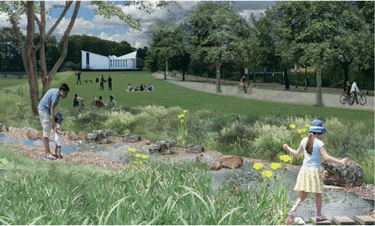Hydro Nation: annual report 2021
Records the development of Scotland's Hydro Nation policy agenda and reports on progress since the publication of the seventh annual report in 2020.
National: Supporting communities and Scotland's water economy
Scotland is a Hydro Nation, one that views and manages its water resources responsibly, and views our relationship, and the ways we work, with the water environment and industry as inextricably linked to our national identity.
Our water sector, including Scottish Water, is worth an estimated £1.7 billion[fn] to the Scottish Economy. We are committed to the sector's growing success and will work with our enterprise agencies and Scotland Development International to support our businesses into new markets. The examples below help to underline how the Hydro Nation agenda is delivering in Scotland, and for Scotland.
Scottish Water: Delivering for you
Scottish Water continues to invest and deliver infrastructure that is fit for communities throughout the country now and for decades to come. Scottish Water has invested £3.9 billion during the 2015-21 regulatory period, improving services for customers. A summary of its achievements is available at annex D.
2021 marked the first year of an ambitious £4.5 billion capital investment programme which will span the 2021-27 period and deliver improvements to drinking water quality and the environment, whilst focussing on making progress towards achieving net-zero emissions by 2040.
Katrine aqueduct - A major upgrade to the Katrine Aqueduct, which serves more than 1.3 million people in parts of Greater Glasgow and the central belt, has been completed. The project to improve and refurbish parts of the two aqueducts, the first 34 miles long and the second 23.5 miles long, which take water from Loch Katrine to two of Scotland's biggest water treatment works, will help improve the security of the water supply to customers for generations to come.

The investment was the latest phase of the biggest upgrade to the megastructure since the first aqueduct was built in 1859 - a total of 17 miles of tunnel sections had concrete and masonry repairs and 10 bridge sections had masonry and metalwork repairs carried out by a team of about 35 workers over the past two years, with a three-month break due to the Covid-19 pandemic.
The aqueduct takes raw water by gravity along its two routes from the south shore of Loch Katrine to the Milngavie and Balmore Water Treatment Works (WTW), just north of Glasgow. Milngavie WTW serves more than 700,000 people across much of the Glasgow area and Balmore WTW serves some 600,000 customers in areas from Bishopbriggs, Lennoxtown and Torrance in the west to parts of north east Glasgow and Cumbernauld, north Motherwell and Linlithgow, Bo'ness and parts of Grangemouth in the east.
Dundee storm-water management - Scottish Water is currently developing storm water management opportunities, in collaboration with Dundee City Council, which will reduce demand on the sewer network and support multiple national agendas for blue/green infrastructure, sustainability, net zero emissions, wellbeing, and creating better places to live.

A project in St Mary's in Dundee, involves working closely with Dundee City Council, and other key stakeholders including SEPA and NatureScot, on the drainage strategy. It was also vital to include the residents living in the area. It is looking at an opportunity for nature based solutions such as ponds, wetland areas and rain gardens as well as incorporating space for cycle paths, trees, playparks and wildflowers planting. Three members of the community planning partnership have been asked to join the core project group. They'll help develop the community aspect of the strategy, and provide valuable feedback from locals.
Phase 1 of the plan will deliver a conveyance route for surface water to manage flood risk in the area through St Leonard's Park. This conveyance route will manage flows in everyday rainfall events, but also have storage areas to help slow down water in larger storm events. Thanks to input from the community, Scottish Water will aim to incorporate features such as a cycle path and a running track around the new burn. The plans also include increased planting, play areas, safer routes to schools and a little bit of open water.

Covid-19 Adaptability
Water sampling
Water quality has been maintained at a very high level over 2015-21 on the standards set out in both Scottish and EU legislation and overseen by the Drinking Water Quality Regulator (DWQR). Water quality monitoring was maintained by Scottish Water throughout the pandemic and when it became clear that access to customer homes would be lost for sampling, a new testing approach was developed with the DWQR. This involved taking samples further upstream in the network at water treatment works, service reservoirs and from the homes of sampling employees, volunteers and commercial premises.
While tests taken during 2020 showed compliance of 99.947%, it is not possible to make a direct year-on-year comparison for results from customers' taps. The issues experienced in 2020-21 have allowed Scottish Water to improve business continuity practices and sampling processes.
Covid-19 Monitoring
A pilot programme of wastewater sampling was carried out by Scottish Water in partnership with the Scottish Environment Protection Agency (SEPA) and the Roslin Institute, giving insight into the prevalence of Covid-19 in the community and likelihood of where further infection clusters might occur. The approach tested for genetic material from the coronavirus in wastewater. Most people infected with the coronavirus are believed to shed it in their faeces even if they have no symptoms, so waste water analysis has helped to identify local outbreaks ahead of a rise in hospital admissions.
The monitoring regime became fully operational in January 2021. The data, via over 200 wastewater samples per week from over 80 locations, has informed health boards and local authorities to deliver community testing and help government track the success of the vaccine roll-out. Analysis on concentrated areas of population in cities has taken place to enhance understanding of the virus spread and shape effective public health suppression efforts.
Investing through a pandemic
On 23 March 2020, Scottish Water's entire capital programme shut down in response to the Covid-19 lockdown. In total, 483 live sites closed within 24 hours. This took a major effort from Scottish Water, their alliance partners and their wider supply chain. Only when Government restrictions were relaxed in June, after three months of closure, did the programme safely and cautiously restart. This was achieved through close collaboration across a network of delivery partners, alliances and wider supply chain partners, ensuring that the safety of personnel and the communities around their works was protected at all times. This collective approach was essential in establishing how to operate in such unprecedented circumstances.
Inevitably, challenges were faced during the year and Scottish Water did experience a very small number of Covid-19 outbreaks at their construction sites. As the pandemic continues, so does the focus on safety, with guidelines regularly reviewed as a result of lessons learned and changes in Government guidelines.
Private water supplies – A framework to deliver universal access to safe drinking water for all
Citizens Advice Scotland (CAS), in partnership with the Drinking Water Quality Regulator (DWQR), commissioned research during 2020-21. The research set out to better understand what would create more resilient and empowered private water supply communities that can respond to the challenges of meeting minimum water quality standards and adapt to climate change impacts.
The summer drought of 2018 saw unprecedented numbers of requests for support from people and communities that had run out of water. This happened again during the dry spring and summer of 2020 and also in 2021. The main barriers that private water supply users face when managing and treating their water supply, as well as coping with climate change impacts such as drought, are:
- the lack of access to information and advice,
- infrequent water sampling creating lack of understanding around water quality,
- lack of suitable funding support and
- a complex and expensive mains connection process.
The research identified the need for an adequate support framework for those on a private supply that addresses affordability issues and offers support to help communities to better manage their water quality as well as improve their resilience to climate change. The development of partnership-based approaches between private water communities and relevant public bodies (e.g. local authorities and Scottish Water) empower communities to effectively self-manage their water supply, access the necessary expertise and develop climate change resilience strategies.
Support for businesses during the pandemic
The COVID-19 pandemic presented unprecedented challenges to businesses and the wider economy in Scotland. Mindful of its statutory duties to promote the interests of customers, it was important to ensure that the industry responded quickly to support non-household customers affected by the pandemic and transition the market back to its normal operations.
Towards the beginning of the pandemic, the Water Industry Commission for Scotland (WICS) implemented a series of steps to support customers and licensed providers affected by the pandemic by developing a customer deferral scheme, which allowed eligible customers in need to defer a certain portion of their charges through their licensed provider. Scottish Water also supported licensed providers by suspending the two-month wholesale prepayment requirement.
As WICS considered how to phase out the current support measures (whilst being mindful of its statutory duties to ensure an orderly functioning of the market and that there is no detriment to the wholesale business of Scottish Water), it worked closely with Scottish Water, Licensed Providers and other stakeholders by establishing an industry-wide Working Group to develop and implement two new voluntary licence conditions, including:
- Support for affected customers through a new deferral scheme which allows licensed providers to defer a portion (or all) of the primary wholesale charges for a given customer.
- Licensed providers to demonstrate their financial resilience to Scottish Water and WICS.
The vast majority of the retail market has formally committed to the new voluntary conditions.
The recast Drinking Water Directive impact
The new EU recast Drinking Water Directive (rDWD) is the first Directive to be transposed post-Brexit, as part of Scotland's commitment to keep pace with EU law. CAS is working with other water sector stakeholders across a number of areas to assess the implications and solutions needed to meet the obligations of the rDWD.
A fundamental principle behind the new rDWD is to ensure access to safe drinking water for all. For consumers, this means ensuring that those on a private water supply are sufficiently equipped to effectively manage their water supply and cope with the impacts of climate change, which have seen many private supplies run dry in recent summers.
Additionally, the rDWD will impact how customers are informed about their water charges and the quality of their drinking water. It also seeks to inform consumers with the information and understanding they need to make water efficient choices. It may also require a new policy on lead water pipe replacement in domestic properties, as part of a new approach to address the health concerns associated with lead.
Improving urban waters
In light of stay-at-home messages during the pandemic, customers and communities are becoming increasingly aware of the natural environment being an important resource for physical and mental well-being. In addition, our water environment provides for the sustainable growth of our economy. The Scottish Government is committed to ensuring our water environment is in the best possible condition. On 22 December 2021 the Minister for Environment and Land Reform gave a statement in the Scottish Parliament to highlight the progress made to date and to explain the proposed investment. On the same day the Scottish Environment Protection Agency (SEPA) published the latest River Basin Management Plan (RBMP3) which sets objectives and provides a programme of actions for delivering improvements to Scotland's water bodies. In tandem, Scottish Water has published an improving urban waters routemap to explain how it will direct its own investment to help achieve improvements under RBMP3.
Contact
Email: waterindustry@gov.scot
There is a problem
Thanks for your feedback